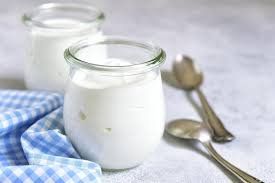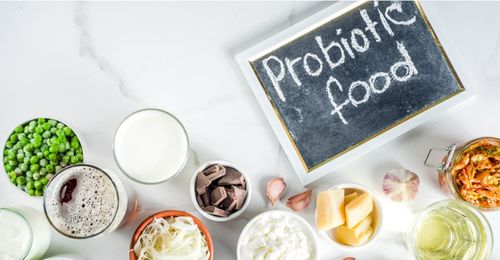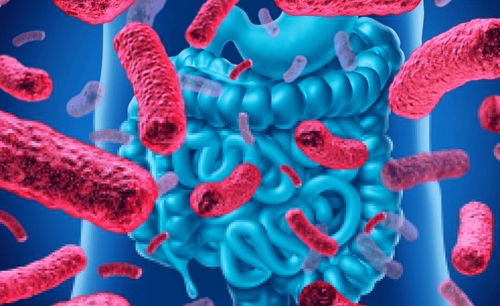This is an automatically translated article.
Yogurt is a very popular and nutritious dairy product that not only provides calcium but also contains many healthy vitamins, especially for the elderly and children.
1. How is yogurt produced?
Yogurt is fresh cow's milk or milk mixed according to a fresh formula for fermentation with beneficial bacteria strains for the intestinal system. The main process that occurs in yogurt fermentation is the conversion of lactose into glucose, then into pyruvic acid and finally lactic acid. Yogurt is known to be a food with high nutritional value and good for health because it is full of substances such as protein, glucide, lipid, mineral salts, especially calcium, vitamins especially group A and vitamins. B. In addition, yogurt has good therapeutic value, especially intestinal diseases.
2. What is the nutrition of yogurt?
Nutritional composition of yogurt includes the following groups of substances:2.1 Protein Plain yogurt made from whole milk can contain about 8.5 g of protein per 245g of yogurt. This protein is divided into 2 types:
Whey: is the smaller soluble protein group in dairy products, accounting for 20% of the protein content in yogurt. Whey protein has long been a popular supplement for athletes and bodybuilders, also helping to lower blood pressure and lose weight.

Sữa chua cung cấp chất dinh dưỡng tốt cho người sử dụng
Casein: are insoluble milk proteins. However, both of these proteins are of good quality, rich in essential amino acids, and have good digestibility.
2.2 Fats There are 400 different types of fat in yogurt, depending on the type of milk it was made from. Yogurt can be made from all types of milk such as whole milk, low-fat or fat-free milk. The fat content of yogurt is as follows:
From 0.4% in fat-free yogurt to 3.3% or more in high-fat yogurt. Most of the fat in yogurt is saturated fat (70%) but also contains a fair amount of monounsaturated fat. Fat in yogurt can provide up to 400 different types of fatty acids. 2.3 Sugar (Carbohydrates) Yogurt contains little natural sugar, in plain yogurt, it is mainly in the form of simple sugars lactose and galactose. The content of substances is as follows:
Lactose content in yogurt is lower than milk, because the bacterial fermentation of yogurt causes lactose to be broken down and converted into galactose and glucose. Most of the glucose will be converted to lactic acid, which makes the product sour. Yogurts also contain significant amounts of added sweeteners such as sucrose (white sugar) and flavoring sugar. The amount of sugar in yogurt is usually not fixed and can range from 4.7% to 18.6% or higher.

Sữa chua cung cấp lượng đường vừa đủ cho cơ thể con người
2.4 Vitamins and minerals Depending on the type of yogurt, there will be different vitamins and minerals. Yogurt made from raw milk will contain a large amount of vitamins and minerals such as:
Vitamin B12. Calcium. Phosphorus: Yogurt is a significant source of phosphorus, which is an essential mineral in the body's biological processes. Riboflavin: also known as vitamin B2 is supplied mainly by dairy products in the modern diet. 2.5 Probiotics Live bacteria that have a positive effect on health, help improve digestion and are found in fermented dairy products such as yogurt. The probiotics in the fermented product are mainly lactic acid bacteria and bifidobacteria. Some of the benefits of probiotics include:
Strengthening the immune system Lowering cholesterol Vitamin synthesis: beneficial bacteria bifidobacterium can synthesize or produce many vitamins such as thiamin, niacin, vitamin B6, vitamin B12, folate and vitamins K Bifidobacterium is also beneficial for the digestive system to help relieve symptoms of irritable bowel syndrome Helps treat diarrhea caused by antibiotics Fights constipation Increases lactose digestibility

Tình trạng táo bón sẽ được cải thiện khi người bệnh sử dụng sữa chua hằng ngày
3. How to use yogurt properly?
Yogurt is obviously very good for health, but the correct use of yogurt is also very important, to be able to take advantage of the benefits without harming the body. To use yogurt properly, note the following:
Yogurt is very effective in re-balancing the intestinal flora as a result of overuse of antibiotics. But supplementation should be done during the course of antibiotics, not during antibiotic use. Yogurt for babies with diarrhea or anorexia will help restore the balance of bacteria in the intestines and the antibiotic lactocidine helps to treat diarrhea. Besides, yogurt is easy to digest, so it is very suitable for children with anorexia. Do not eat yogurt on an empty stomach: the reason is that eating yogurt on an empty stomach will cause lactic acid to be easily destroyed and make yogurt ineffective. The appropriate pH for lactic acid to grow and develop is from 4-5. It is best to eat yogurt only for 1-2 hours after a meal Do not heat yogurt: because it will lose its useful effect and reduce the taste of yogurt. To ensure the effect of yogurt and not cause sore throats in children due to cold storage, it is recommended to take the yogurt out of the refrigerator 15-30 minutes before. To register for examination and treatment at Vinmec International General Hospital, you can contact Vinmec Health System nationwide, or register online HERE.













